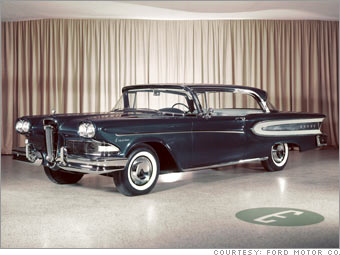The Edsel wasn't just a car. It was supposed to be a whole new car line. There were seven Edsel models altogether, including three wagons: the Ranger, the Pacer, the Corsair, the Citation, the Roundup, the Villager and the Bermuda.
In retrospect, Edsel's marketing mission looks suicidal. In the 1950s, Ford saw some demographic daylight between Ford and Mercury and between Mercury and Lincoln and a single brand, Edsel, was conceived to fill both those gaps. The Edsel was supposed to be sophisticated and technologically advanced - you could shift gears by pushing buttons on the steering wheel - but the name is synonymous today with "colossal marketing flame-out."
Ironically, the Edsel was named after Henry Ford's son, Edsel Ford. As Ford Motor Co. CEO in the 1920s, Edsel was known for his elegant sense of style. In contrast to his father, who built the company on the dirt-cheap and rugged Model T - "any color as long it's black" - Edsel recognized the importance of good design in the mature automobile business. His guidance was a big reason the Model A looked so much handsomer than the Model T.
The Edsel cars' aptly named "horse collar" grill was immediately the focal point of crude jokes. But mechanical problems in the early cars, a market shift toward smaller cars and a general economic downturn just as the models were hitting showrooms probably did as much as anything to seal Edsel's fate. If times had been richer, Ford might have just changed the grill.

